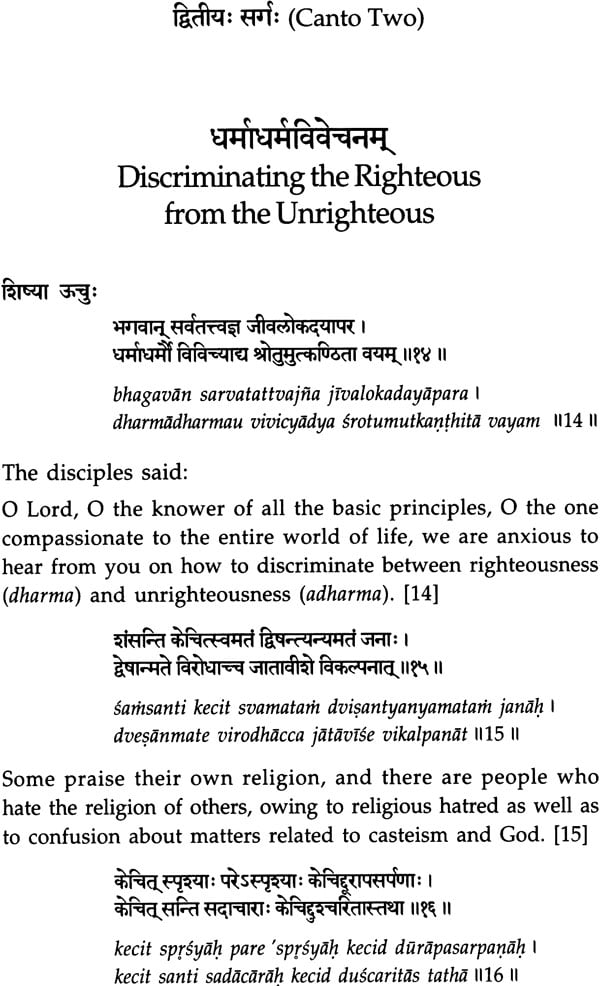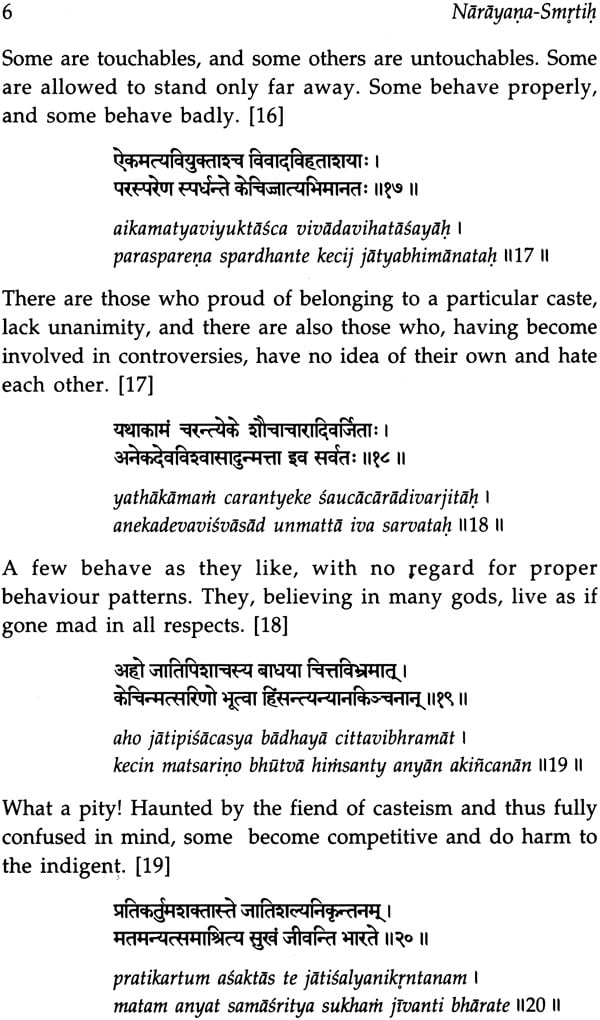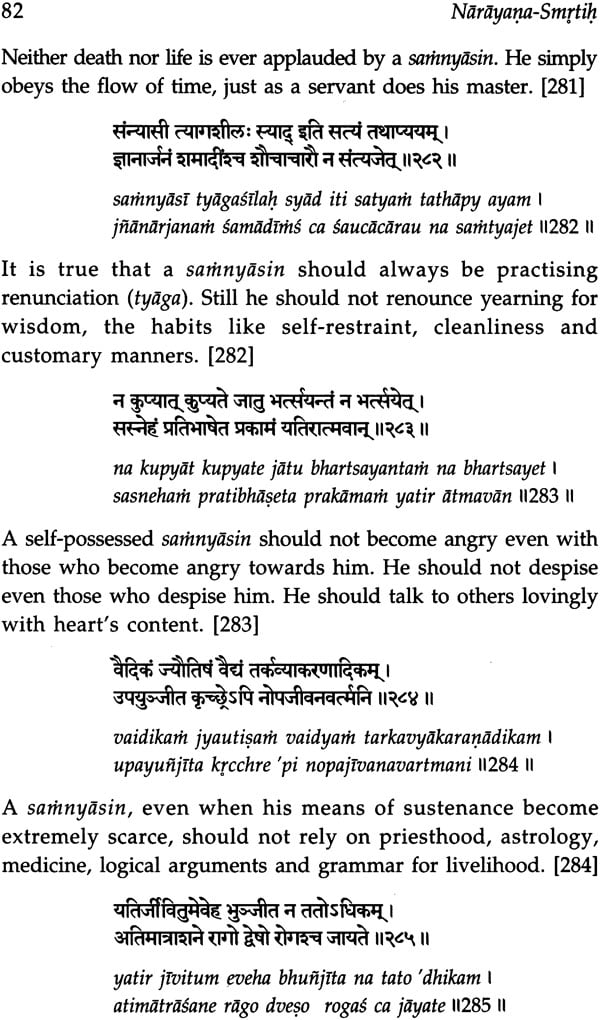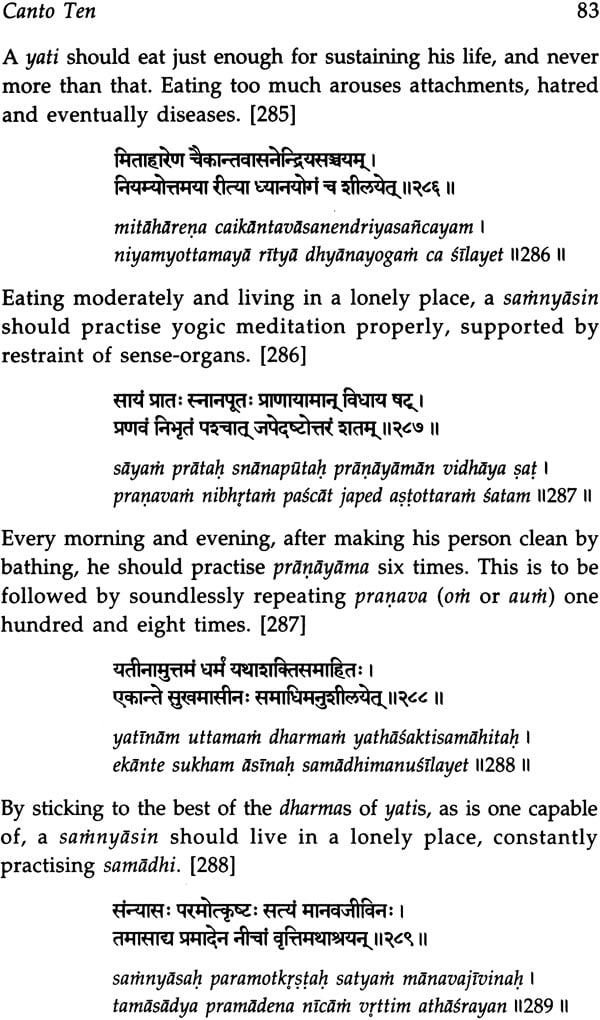
Narayana-Smrtih
Book Specification
| Item Code: | IDJ254 |
| Author: | Swami Muni Narayana Prasad |
| Publisher: | D. K. Printworld Pvt. Ltd. |
| Language: | English & Sanskrit |
| Edition: | 2007 |
| ISBN: | 8124603928 |
| Pages: | 75 |
| Cover: | Paperback |
| Other Details | 8.5 inch X 5.5 inch |
| Weight | 140 gm |
Book Description
Preface
The source-books of Indian spirituality could generally be classified as srutis and smrtis. Sruti means "that which is heard." Srutis contain words uttered by the great rsis or seers of the past expounding the ultimate secret they visualized about the meaning and content of our life, and of the world as a whole. In other words, srutis correlate three basic realities: my existence, the existence of the world I perceive, and the one ultimate Reality underlying both. The best examples of this type of spiritual literature are the Upanisads. The Vedas are also generally counted as Srutis. The reality revealed in such scriptures are of eternal value, meaningful everywhere at any time. The philosophical works of Narayana Guru, like Atmopadesa Satakam (One Hundred Verses of Self-Instruction) Darsanamala (Garland of Visions) and the like are of this order.
The word smrti means "that which is remembered." Man is supposed to live in this world of practical affairs by constantly recalling the eternal truths taught in the srutis; only then does life become meaningful. A life lived thus naturally follows certain well-set behaviour patterns. Certain actions would be taboos, and certain others would be enjoined. The former type of directives is known as nisedha (prohibitions), and the latter uidhi (directives). The instructional texts written by those who have realized the Reality, giving details of both these kinds of practices re known as smrtis.
Even as the eternal truth remains one and immutable, necessary adjustments to fit in with time and clime have to be made in the rules of behaviour we formulate with that truth for their firm basis. S nrtis, in other words, are the scriptures that give detailed instructions on prohibitions and directives in life, which necessarily have to make provision for the exigencies of changing temporal and spatial conditions. Such scriptures are known also as Dharmasastras (scriptures on righteousness). Manu-Smrti is well known among such. Yajnavalkya-Smrti, Parasara-Smrti and Narada-Smrti are other similar ancient Dharmasastras. Puranas (mythological legends) and Itihasas (epics) are also classed under smrtis, for the reason that these texts give emphasis to moral lessons by way of telling stories, rather than to wisdom teaching proper, though references to such could be found in these.
One well-acquainted with the wisdom teaching of srutis need no practical instructions to guide one's life. Such a one's life naturally follows the right path in line with the ultimate truth he knows. Smrtis, thus, are scriptures meant for those who are not familiar with the depth of the wisdom-teachings of srutis. The latter thus being virtually inclusive of the former, the seers who formulate scriptures of the sruti-type do not usually compose scriptures of the smrti-type. Perhaps Vyasa is the one exception to this rule. In fact, Vyasa is not counted as the name o f a particular person, but of a long line of masters or rather editors who composed or edited scriptures both of the sruti and smrti types.
All the works of Narayana Guru, even including the hymns, are of the sruti-type. Still it is well known how much he was interested is seeing his wisdom reflected in the day-today life of humanity, in its individual and social dimensions. Those who are not adepts in scriptural wisdom also have to lead a morally sound life, which requires guidance from authentic persons. The present work, Narayana-Smrtih, was written with this end in view.
The Guru, in conformity with customs, did not write it himself. Instead he asked his disciple Swami Atmananda to write it, while offering all the required ideas and guidelines. What the disciple has conveyed through this book in his language contains the ideas and ideals conveyed to him by the Guru. Swami Atmananda himself writes about the origination of this book thus:
This book contains the teachings imparted by Sri Narayana Guru at Sivagiri Mutt in the month of Cingam (August-September) of the Year 1100 ME (AD 1924). The Guru entrusted me with the task of versifying these dharma-teachings. What I wrote down each day was read out to the Guru Daily, followed by his suggesting necessary corrections. The book thus was completed in a month's time.
Smrtis define dharma as follows:
Proper activities suitable to the exigencies of time and clime are called dharma.
desakalocitam karma dharma jnatyabhidhiyate!
Accodingly, the behaviour patterns and belief patterns of people undergo change in accordance with the needs of time and clime. Even when differing in respect of clothing styles and language spoken, humans (at a particular time and clime) have to have something common in respect of customary behaviour and well-established views of life.
The ideas dealt with in the present work are in conformity with such a requirement. Intent on doing away with extravagances and unreasonable pomps, the Guru, the knower of the past, present and future, had brought into practice new social customs in conformity with the requirements of the time, as early as thirty-nine years ago. Many of those ideals find place in the present work. Each one adhering to these instructions strictly, will render any other means unnecessary for the actualizations of unity of religions and belief patterns, for the well-being of the world and also for world-peace.
This work is named Narayana-Smrtih because it conforms to the style of ancient smrit-texts like Manu-Smrtih and Yajnavalkya-Smrtih.
The ancient texts like Manu-Smrtih were written long long ago when temporal, spatial and social conditions were much different from what we have now. Many of the prohibitions and commands given in such texts are apparently outdated now. Many do therefore find fault with such texts altogether. Mere finding fault with an old law or system does no good. What we need is clear-cut guidance acceptable and suitable to the modern times. In other words, we need a new smrti-text befitting the new age. The lacuna that remained thus unfilled was filled by Narayana Guru with one of his disciples as the instrument.
This text definitely will serve as a dependable guide to everyone who intends to live basing his life, both individual and social, on the one ultimate Reality. Those who follow its directives will certainly feel the Guru himself having come before them as a reliable guide.
Though originally written in Sanskrit, it so far has been available in print in the Malayalam script only; nor was any translation or commentary on it available in any other language. This is the first time the Narayana-Smrtih comes out with an English translation so that those who are outside Kerala may also have the benefit of it.
Back of the Book
Smrtis, in Indian spiritual lore, denote the class of canonical texts that teach traditional laws, civil or religious, as against srutis that reveal the eternal Reality. Such laws, as is to be presumed, need periodical revision or modification, or even total nullifying and replacement.
Narayana Guru took up the challenge to write a new Smrti text when he felt that the two-thousand-years old Manusmrti has became outdated for modern times.
Narayana Smrti is an alternative new text fit for current times while being fully in conformity with the traditional wisdom, espoused in Indian literature.
Narayana Guru, the author of Narayana Smrti was a rsi, a philosopher and a poet as confirmed by the various literary works he created in the spiritual field. Swami Atmananda, the translator, is a direct disciple of Nataraja Guru, the well-known commentator on Narayana Guru's major works, is a great Sanskrit scholar himself and has authored several illustrious works in the sphere of philosophy and spirituality.
| | ||
| Preface | V | |
| Canto One | 1 | |
| Introduction | ||
| Canto Two | 5 | |
| Discriminating the Righteous from the Unrighteous | ||
| Reflections on Oneness of jati | 10 | |
| Reflection on Oneness of faith | 13 | |
| Reflection on Oneness of God | 17 | |
| Canto Three | 20 | |
| Dharma in General | ||
| Fivefold Purities | 26 | |
| Canto Four | 30 | |
| Childbirth | ||
| Caring for the Child | 33 | |
| Initiation into Formal Education | 34 | |
| Canto Five | 36 | |
| Duties Related to Each Stage of life | ||
| Canto Six | 41 | |
| Studenthood | ||
| Canto Seven | 50 | |
| Being a Householder | ||
| Canto Eight | 55 | |
| Five Great Sacrifices | ||
| Canto Nine | 71 | |
| Funeral Rites | ||
| Canto Ten | 75 | |
| Renunciation of Samnyasa |









